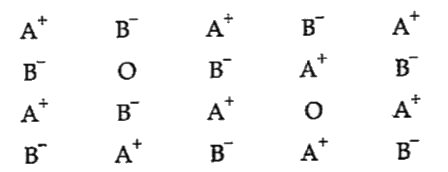How Schottky and Frenkel defects occur in ionic crystals? How does the density of a crystal gets affected by the presence of these defects ?
To answer the question regarding Schottky and Frenkel defects in ionic crystals and their effect on density, we can break down the solution into clear steps:
1. Understanding Schottky Defect:
- A Schottky defect occurs when an equal number of cations and anions are missing from their lattice points in an ionic crystal.
- This results in vacancies in the crystal lattice.
- For example, in a crystal like sodium chloride (NaCl), if one sodium ion (Na⁺) and one chloride ion (Cl⁻) are missing, this creates a Schottky defect.
2. Visualizing Schottky Defect:
- Imagine a crystal lattice where cations and anions are arranged alternately. When a cation and an anion are missing, the lattice structure has vacancies that disrupt the regular arrangement.
3. Understanding Frenkel Defect:
- A Frenkel defect occurs when a cation moves from its lattice position to an interstitial site (a space between the regular lattice points).
- This defect is characterized by the presence of a vacancy where the cation was originally located and an additional cation in the interstitial site.
- For example, in silver bromide (AgBr), a silver ion (Ag⁺) may leave its lattice site and occupy an interstitial position.
4. Visualizing Frenkel Defect:
- In the crystal lattice, one cation moves to a position that is not a regular lattice point, creating a vacancy and an interstitial cation.
5. Effect on Density:
- Schottky Defect: The density of the crystal decreases because there are fewer ions in the lattice due to the missing cations and anions.
- Frenkel Defect: The density remains the same because although a cation is displaced, no ions are lost from the crystal; they are merely relocated.
Summary:
- Schottky defects involve missing ions, leading to a decrease in density.
- Frenkel defects involve cations moving to interstitial sites, resulting in no change in density.
- A Schottky defect occurs when an equal number of cations and anions are missing from their lattice points in an ionic crystal.
- This results in vacancies in the crystal lattice.
- For example, in a crystal like sodium chloride (NaCl), if one sodium ion (Na⁺) and one chloride ion (Cl⁻) are missing, this creates a Schottky defect.
- Imagine a crystal lattice where cations and anions are arranged alternately. When a cation and an anion are missing, the lattice structure has vacancies that disrupt the regular arrangement.
- A Frenkel defect occurs when a cation moves from its lattice position to an interstitial site (a space between the regular lattice points).
- This defect is characterized by the presence of a vacancy where the cation was originally located and an additional cation in the interstitial site.
- For example, in silver bromide (AgBr), a silver ion (Ag⁺) may leave its lattice site and occupy an interstitial position.
- In the crystal lattice, one cation moves to a position that is not a regular lattice point, creating a vacancy and an interstitial cation.
- Schottky Defect: The density of the crystal decreases because there are fewer ions in the lattice due to the missing cations and anions.
- Frenkel Defect: The density remains the same because although a cation is displaced, no ions are lost from the crystal; they are merely relocated.
- Schottky defects involve missing ions, leading to a decrease in density.
- Frenkel defects involve cations moving to interstitial sites, resulting in no change in density.
Topper's Solved these Questions
- SOLID STATEBOOK - ICSECHAPTER - SOLID STATEEXERCISE - ISC EXAMINATION QUESTIONS PART-I (Objective Question)
5 Videos
- SOLID STATEBOOK - ICSECHAPTER - SOLID STATEEXERCISE - ISC EXAMINATION QUESTIONS PART-I (Objective Question) (Complete the following statements by selecting the correct alternative from the choices given)
1 Videos
- SOLID STATEBOOK - ICSECHAPTER - SOLID STATEEXERCISE - EXERCISE (PART-II DESCRIPTIVE QUESTIONS) (SHORT ANSWER QUESTIONS)
37 Videos
- SELF ASSESSMENT PAPER-8BOOK - ICSECHAPTER - SELF ASSESSMENT PAPER-8EXERCISE - QUESTIONS
11 Videos
- SOLUTIONSBOOK - ICSECHAPTER - SOLUTIONSEXERCISE - MULTIPLE CHOICE QUESTIONS (Assertion and Reason based questions)
10 Videos
Similar Questions
Knowledge Check
Examine the given defected crystal

Answer the following questions:
How is the density of crystal affected by this defect?ASchottky defect, decreases, NaCl and KCl etcBFrenkel defect, increases, As and Si etcCSchottky defect, increases, As and Bi etcDFrenkel defect, decreases, NaCl, KCl etc
How does the density of crystal change due to Schottky defects ?
View SolutionExplain the Schottky defects in stoichiometric crystals.
View SolutionWhat are metal excess defects in crystals ? How are these caused ?
View SolutionWhich defect causes decreases in the density of crystal?
View SolutionWhich defect causes decreases in the density of crystal?
View SolutionExamiine the given defective crystal

(i) What type of stoichiometric defect is shown by the the crystal ?
(ii) How is the density of the crystal affected by this defect ?
(iii) What type of ionic substance show such defect ?
View SolutionExplain Frenkel defect in ionic crystals. What type of compounds exhibit this defect ?
View Solution
